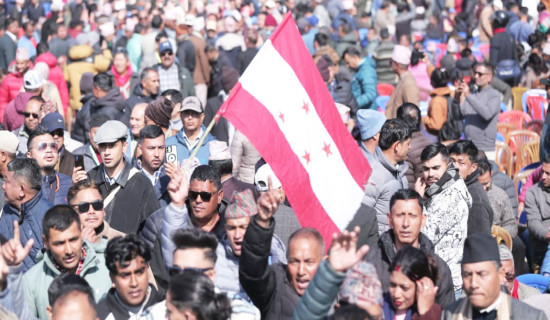- Monday, 12 January 2026
Local initiatives and power of grassroots movements for climate action
Basu Gautam

In an era
where the consequences of climate change are becoming increasingly evident, the
imperative for swift and resolute action is undeniably clear. These movements,
both small and large in scale, are playing a pivotal and transformative role in
the fight against climate change. These movements are defined by their organic
origins, springing forth from the hearts and minds of those who intimately
understand the unique challenges their regions face. They have transcended
geographic boundaries to become a global force for change. They channel the
energy and passion of countless volunteers, activists, and advocates, working
tirelessly to advance sustainability and environmental justice.
One of the
most significant contributions of grassroots climate movements is their ability
to build public awareness and engagement on climate issues. Grassroots climate
movements are also holding governments and corporations accountable for their
climate commitments. Grassroots climate movements are making a significant
impact in a variety of ways. This is essential for driving the systemic changes
needed to address the climate crisis
By
advocating for environmental justice and inclusivity, these movements ensure
that the burden of climate change does not disproportionately fall upon
marginalized communities. These movements are not only responding to the urgent
demands of the climate crisis but are also pioneering new approaches to environmental
stewardship and social justice. They understand that addressing climate change
necessitates more than just reducing greenhouse gas emissions; it requires
reimagining our societal values, systems, and priorities. These movements,
regardless of their size, are assuming a pivotal and transformative role in the
fight against climate change. Moreover, these movements are not confined by
geographic boundaries; they are a global force for change. Grassroots activists
and advocates are harnessing the energy and passion of countless volunteers,
driven by a shared commitment to advancing sustainability and environmental
justice. They are not top-down initiatives dictated by distant authorities;
instead, they spring forth from the hearts and minds of those who intimately
understand the unique challenges their regions face.
For example
grassroots climate movements in South Asia are playing a crucial role in the
fight against climate change. Some of
the examples include:
Climate
Action Network South Asia (CANSA): A network of civil society organizations
working to advance climate action in South Asia. By working to address the
unique challenges faced by the region, these movements are offering valuable
insights to the global climate movement.
Bangladesh
Rural Advancement Committee (BRAC): A non-governmental organization that has
been working to empower rural communities and build resilience to climate
change.
South Asian
Network on Dams, Rivers and People (SANDRP): A network of organizations and
individuals working to promote sustainable water management and protect the
rights of riverine communities. These movements, both small and large in scale,
are marked by their organic origins and profound understanding of the unique
climate-related issues that each region faces.
Through
community events, workshops, and educational programs, grassroots movements are
distilling the complexities of climate change into relatable, digestible
information that resonates with people from all walks of life. Workshops and
educational programs offered by these movements are equipping individuals with
the tools, knowledge, and practical skills needed to address climate challenges
effectively. Perhaps the most profound impact of these education and engagement
efforts is the fostering of a collective sense of responsibility. Grassroots
movements are inspiring individuals to recognize that they are not passive
bystanders but active participants in the fight against climate change. By
nurturing a sense of shared ownership over the planet's well-being, these
movements are cultivating a profound ethos of stewardship and accountability.
Through education and engagement, they are also sowing a collective
responsibility that transcends geographic and cultural boundaries, driving home
the message that the fight against climate change is a shared endeavor, one in
which every individual has a role to play.
One of the
primary functions of grassroots movements is to shine a relentless spotlight on
climate-related policies, decisions, and corporate practices that have the
potential to harm the environment. They act as a critical counterbalance to the
often opaque or self-interested actions of governments and corporations.
Through their advocacy and activism, grassroots movements bring these issues to
the forefront of public consciousness, ensuring that they do not remain hidden
or go unchallenged. Protests, petitions, and grassroots lobbying efforts are
the tools of the trade for these movements. Grassroots lobbying involves
engaging directly with policymakers and decision-makers at various levels of
government and industry, urging them to prioritize sustainable policies and
practices. In doing so, grassroots movements exert pressure for transparency,
accountability, and the implementation of sustainable policies at all levels of
society. They compel decision-makers to acknowledge the urgent need for action
and to prioritize the long-term health of the planet over short-term interests.
In essence, grassroots movements are a driving force for transparency and
accountability in the climate arena. Their unwavering dedication to
environmental causes ensures that climate-related policies and practices are
subject to scrutiny and are guided by the principles of sustainability and
responsibility. In an era where climate change presents an existential threat,
their watchdog role is indispensable in ensuring that the world's leaders and
corporate entities remain steadfast in their commitment to safeguarding the
planet for future generations.
Grassroots
climate movements are playing a vital role in the fight against climate change.
These movements are rooted in local communities, and their unique perspectives
and innovative solutions are essential to building a more sustainable future.
One of the key contributions of grassroots climate movements is their ability
to pioneer and champion innovative solutions to climate challenges. Whether
it's developing community-owned renewable energy projects, creating urban green
spaces, or establishing local recycling programs, these initiatives are
showcasing what's possible at a local level and inspiring broader change.
Grassroots
climate movements are also excelling at mobilizing collective action. They
bring together people from diverse backgrounds, fostering a sense of unity and
shared purpose. This collective power can influence decision-makers and drive
policy changes. From school strikes for climate to community-led tree-planting
initiatives, grassroots movements are inspiring individuals to take part in the
global climate movement. In addition to their focus on innovation and
mobilization, grassroots climate movements are also playing a critical role in
building resilience to the impacts of climate change. Communities hit hardest
by climate impacts, such as rising sea levels or extreme weather events, are
finding innovative ways to adapt and protect their livelihoods. Grassroots
movements are helping these communities become more resilient, ensuring they
can withstand the challenges of a changing climate.
While
grassroots climate movements may start locally, their impact can extend far
beyond their immediate communities. These movements can influence international
climate agendas by drawing attention to critical issues, advocating for just
and equitable climate policies, and showcasing successful local climate
solutions that can be scaled up globally. Grassroots climate movements are the
embodiment of the idea that change begins at home. They bring a unique and
invaluable perspective to the global effort to combat climate change.
(Gautam is
the President of Lumbini World Peace Forum and a grassroots climate activist
through his “1 Million Trees Plantation and Conservation Campaign”)
















